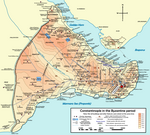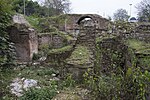Aksaray (Istanbul Metro)
1989 establishments in TurkeyFatihIstanbul metro stationsIstanbul metro stubsRailway stations opened in 1989 ... and 1 more
Turkish railway station stubs

Aksaray is a rapid transit station on the M1 line of the Istanbul Metro. It is located in central Fatih under Adnan Menderes Boulevard near Aksaray square. Aksaray was opened on 3 September 1989 as part of the first rapid transit line in Istanbul and Turkey. Between 1989 and 2014, Aksaray was the eastern terminus of the M1. On 9 November 2014, the M1 was extended 0.8 kilometres (0.50 mi) south to Yenikapı Transfer Center where connections to the M1 line and Marmaray as well as İDO seabus service are available. From Aksaray connection to the T1 tram line is available via a short walk to Yusufpaşa station. Connections to İETT bus service are also available.
Excerpt from the Wikipedia article Aksaray (Istanbul Metro) (License: CC BY-SA 3.0, Authors, Images).Aksaray (Istanbul Metro)
Adnan Menderes Vatan Boulevard, Istanbul
Geographical coordinates (GPS) Address Nearby Places Show on map
Geographical coordinates (GPS)
| Latitude | Longitude |
|---|---|
| N 41.0111 ° | E 28.9489 ° |
Address
Adnan Menderes Vatan Bulvarı (Vatan Caddesi)
Adnan Menderes Vatan Boulevard
34080 Istanbul
Türkiye
Open on Google Maps










